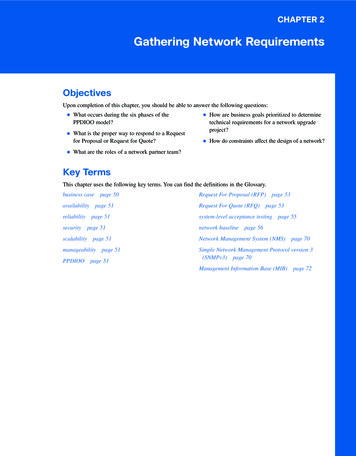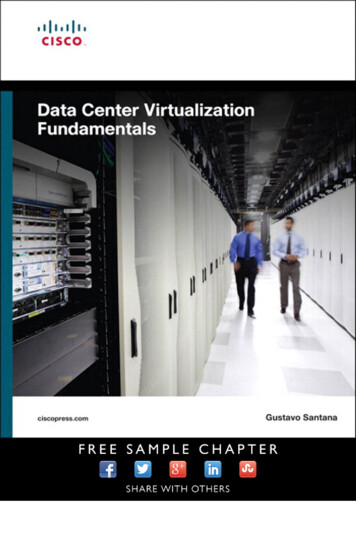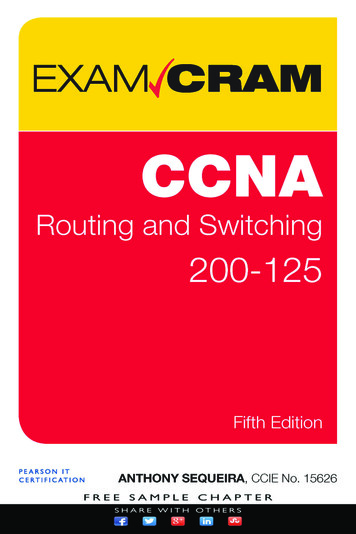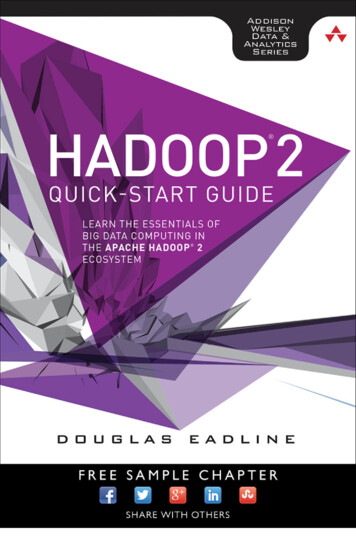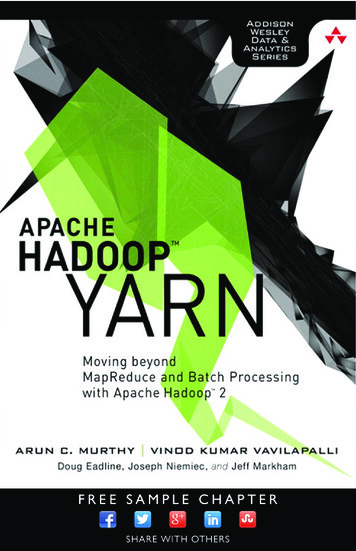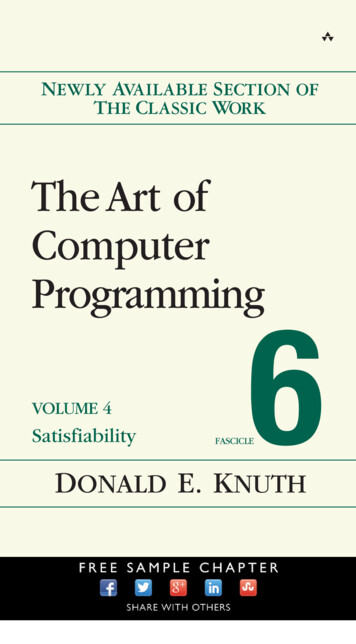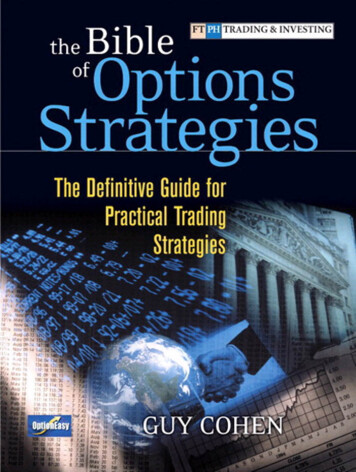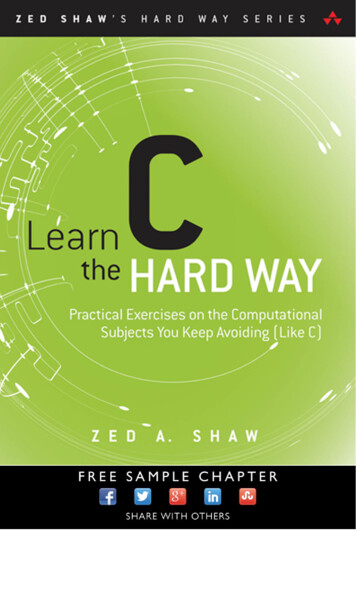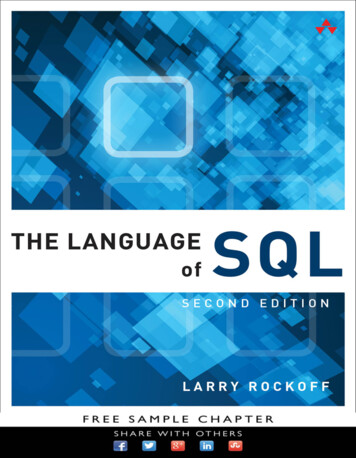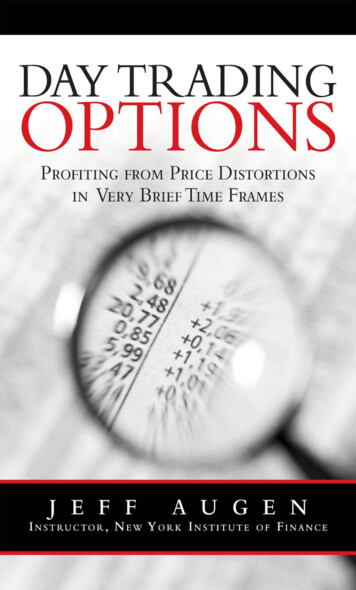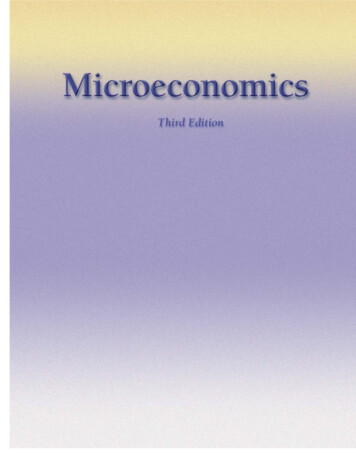
Transcription
The Addison-Wesley Series in als of EconomicsParkinEconomicsBade/ParkinFoundations of EconomicsGregory/StuartRussian and Soviet EconomicPerformance and e Theory with EconomicApplicationsBinger/HoffmanMicroeconomics with CalculusBoyerPrinciples of TransportationEconomicsBransonMacroeconomic Theoryand PolicyBrucePublic Finance and the Modern Industrial OrganizationCaves/Frankel/JonesWorld Trade and PaymentsChapmanEnvironmental Economics:Theory, Application, and PolicyCooter/UlenLaw and EconomicsDownsAn Economic Theory ofDemocracyEhrenberg/SmithModern Labor EconomicsEkelund/TollisonEconomicsFusfeldThe Age of the EconomistGerberInternational EconomicsGhiaraLearning EconomicsGordonMacroeconomicsHartwick/OlewilerThe Economics of NaturalResource UseHubbardMoney, the Financial System,and the EconomyPhelpsHealth mics: A Tool for CriticallyUnderstanding SocietyHughes/CainAmerican Economic HistoryRitter/Silber/UdellPrinciples of Money, Banking,and Financial MarketsHusted/MelvinInternational EconomicsRohlfIntroduction to EconomicReasoningJehle/RenyAdvanced Microeconomic TheoryRuffin/GregoryPrinciples of EconomicsKleinMathematical Methodsfor EconomicsSargentRational Expectationsand InflationKrugman/ObstfeldInternational EconomicsSchererIndustry Structure, Strategy,and Public PolicyLaidlerThe Demand for MoneyLeeds/von AllmenThe Economics of onal Moneyand FinanceMillerEconomics TodayMiller/Benjamin/NorthThe Economics of Public IssuesMiller/BenjaminThe Economics of Macro IssuesMills/HamiltonUrban EconomicsMishkinThe Economics of Money,Banking, and Financial ion to EconometricsStudenmundUsing EconometricsTietenbergEnvironmental and NaturalResource EconomicsTietenbergEnvironmental Economicsand PolicyTodaro/SmithEconomic strial OrganizationWilliamsonMacroeconomics
JEFFREY M. PERLOFFUniversity of California, Berkeley
To my mother, Mimi PerloffEditor-in-ChiefSenior EditorExecutive Development ManagerDevelopment EditorManaging EditorProduction SupervisorSenior Marketing ManagerCover and Interior DesignSenior Media ProducerCompositionSenior Manufacturing BuyerIllustratorProject ManagementCover ImageDenise ClintonVictoria WarneckSylvia MallorySylvia MalloryJames RigneyKatherine WatsonStephen FrailRegina KolendaMelissa HonigScott Silva and Elm Street Publishing Services, Inc.Hugh CrawfordJim McLaughlinElm Street Publishing Services, Inc. Hideki Kuwajima/PhotonicaPhoto credits appear on page A-63, which constitutes a continuation of the copyright page.ISBN: 0-321-16073-8P-copy ISBN: 0-321-20037-3Library of Congress Cataloging-in-Publication DataPerloff, Jeffrey M.Microeconomics / Jeffrey M. Perloff. — 3rd ed.p. cm.Includes bibliographical references and index.ISBN 0-321-16073-81. Microeconomics. I. Title.HB172.P39 2004338.5— dc212002038352Copyright 2004 by Pearson Education, Inc., publishing as Pearson Addison Wesley.All rights reserved. No part of this publication may be reproduced, stored in a retrieval system, ortransmitted, in any form or by any means, electronic, mechanical photocopying, recording, or otherwise, without the prior written permission of the publisher. Printed in the United States of America.1 2 3 4 5 6 7 8 9 10 —QWT— 07 06 05 04 03
C O N T E N T SPrefacexvCHAPTER 11.1IntroductionEffects of Government Import Policieson Supply Curves 24SOLVED PROBLEM 2.1 251Microeconomics: The Allocation ofScarce Resources 1Trade-Offs 2Who Makes the Decisions 2APPLICATION Oregon Decides Which MedicalTreatments to Provide 2Prices Determine Allocations 3APPLICATION Twinkie Tax 41.2Models2.3Market Equilibrium2.4Shocking the Equilibrium2.5Effects of Government Interventions2.6When to Use the Supply-and-DemandModel 41427Using a Graph to Determine the Equilibrium 27Using Math to Determine the Equilibrium 27Forces That Drive the Marketto Equilibrium 2830Effects of a Shift in the Demand Curve 30Effects of a Shift in the Supply Curve 31SOLVED PROBLEM 2.2 31APPLICATION Income Threshold Modeland China 5Simplifications by AssumptionTesting Theories 6Positive Versus Normative 71.35Uses of Microeconomic Models8Uses of Microeconomics by Individiualsand Governments 9APPLICATION Putting Saturn in Orbit 9Summary12PART ONE SUPPLY AND DEMANDCHAPTER 22.12.2Supply and Demand1332Policies that Shift Supply Curves 32SOLVED PROBLEM 2.3 34APPLICATION American Steel Quotas 35Policies that Cause Demand to Differfrom Supply 35APPLICATION Zimbabwe Price Controls 38APPLICATION Minimum Wage Lawin Puerto Rico 40Why Supply Need Not Equal Demand 40Summary 42Questions 43Problems 45Demand14The Demand Curve 15The Demand Function 18Summing Demand Curves 20APPLICATION Aggregating the Demandfor Cling Peaches 20Supply21The Supply Curve 21The Supply Function 23Summing Supply Curves 24CHAPTER 3Applying the Supplyand-Demand Model3.1How Shapes of Demand and SupplyCurves Matter 473.2Sensitivity of Quantity Demandedto Price 48Price Elasticity of Demand 48APPLICATION Web Fees 5046
viContentsElasticity Along the Demand CurveOther Demand Elasticities 533.350Effect of a Change in Income onConsumption 90SOLVED PROBLEM 4.2 91Sensitivity of Quantity Supplied to PriceElasticity of Supply 55Elasticity Along the Supply Curve3.4Long Run Versus Short Run3.5Effects of a Sales Tax554.45657Demand Elasticities over Time 57Supply Elasticities over Time 5858Two Types of Sales Taxes 58Equilibrium Effects of a Specific Tax 59APPLICATION Discouraging Smoking 61Tax Incidence of a Specific Tax 62SOLVED PROBLEM 3.1 63APPLICATION Gasoline Taxes as aRevenue Source 65The Same Equilibrium No MatterWho Is Taxed 65The Similar Effects of Ad Valorem andSpecific Taxes 66SOLVED PROBLEM 3.2 68APPLICATION Incidence of FederalAd Valorem Taxes 69CHAPTER 54.24.3Applying ConsumerTheory 1065.1Deriving Demand Curves5.2How Changes in Income ShiftDemand Curves 110107Effects of a Rise in Income 110SOLVED PROBLEM 5.1 112Consumer Theory and Income ElasticitiesAPPLICATION Income Elasticities ofDemand for Cars 117PART TWO CONSUMER THEORY4.192The Consumer’s Optimal Bundle 92SOLVED PROBLEM 4.3 95APPLICATION Taxes and Internet Shopping 96 Optimal Bundles on Convex Sections ofIndifference Curves 97Buying Where More Is Better 98SOLVED PROBLEM 4.4 98Food Stamps 100APPLICATION Food Stamp Experiments 101Summary 103Questions 104Problems 105Summary 70Questions 70Problems 72CHAPTER 4Constrained Consumer ChoiceConsumer Choice5.3Effects of a Price Change5.4Cost-of-Living Adjustments5.5Deriving Labor Supply Curves73Preferences74Properties of Consumer Preferences 75Preference Maps 76SOLVED PROBLEM 4.1 79APPLICATION Indifference Curves BetweenFood and Clothing 83Utility84Utility Function 84Ordinal Preferences 84Utility and Indifference Curves 85Utility and Marginal Utility 85Utility and Marginal Rates of Substitution87Budget Constraint87Slope of the Budget Constraint 89Purchasing Fractional Quantities 90Effect of a Change in Price on Consumption90113118Income and Substitution Effects with aNormal Good 118Income and Substitution Effects with anInferior Good 120SOLVED PROBLEM 5.2 122APPLICATION Shipping the Good Stuff Away 122123Inflation Indexes 123APPLICATION Does Inflation Hurt? 125Effects of Inflation Adjustments 126APPLICATION Fixing the CPI SubstitutionBias 129131Labor-Leisure Choice 131Income and Substitution Effects 133SOLVED PROBLEM 5.3 134APPLICATION Leisure-Income Choicesof Textile Workers 136Shape of the Labor Supply Curve 137
viiContentsIncome Tax Rates and Labor Supply 138APPLICATION Winning the Good Life 140Innovations175APPLICATION Nonneutral Technical Changein Pin Manufacturing 177Summary 141Questions 142Problems 143APPLICATION Dell Computer’s OrganizationalInnovations 177CROSS-CHAPTER ANALYSIS: Child-Care Subsidies144PART THREE THEORY OF THE FIRMCHAPTER 66.1Firms andProduction6.37.1Measuring Costs7.2Short-Run Costs7.3Long-Run CostsThe Ownership and Managementof Firms 148Production150Production Functions 151Time and the Variability of Inputs151Short-Run Production: One Variableand One Fixed Input 152Total Product 153Marginal Product of Labor 153Average Product of Labor 154Graphing the Product Curves 154Law of Diminishing Marginal Returns 157APPLICATION Malthus and Mass Starvation 1586.4CHAPTER 7147The Ownership of Firms 149The Management of Firms 149What Owners Want 1506.2Summary 178Questions 179Problems 180160APPLICATION A Semiconductor IntegratedCircuit Isoquant 163Substituting Inputs 165SOLVED PROBLEM 6.1 1676.56.6Returns to Scale168Constant, Increasing, and DecreasingReturns to Scale 168SOLVED PROBLEM 6.2 170APPLICATION Returns to Scale inManufacturing 170Varying Returns to Scale 173Productivity and Technical ChangeRelative Productivity 174APPLICATION German Versus BritishProductivity 1757.4174182183Economic Cost 183APPLICATION Opportunity Cost ofWaiting Time 184Capital Costs 184APPLICATION Swarthmore College’s Costof Capital 185186Short-Run Cost Measures 186APPLICATION Lowering Transaction Costs for UsedGoods at eBay and Abebooks 188Short-Run Cost Curves 189Production Functions and the Shape ofCost Curves 191APPLICATION Short-Run Cost Curves fora Printing Firm 194Effects of Taxes on Costs 195SOLVED PROBLEM 7.1 197Short-Run Cost Summary 198198199APPLICATION Rice Milling on Java 204SOLVED PROBLEM 7.2 207How Long-Run Cost Varies with Output 207SOLVED PROBLEM 7.3 209The Shape of Long-Run Cost Curves 209APPLICATION Average Cost of Cement Firms 213Estimating Cost Curves VersusIntrospection 213Input ChoiceLong-Run Production:Two Variable Inputs 159IsoquantsCostsLower Costs in the Long Run214Long-Run Average Cost as the Envelopeof Short-Run Average Cost Curves 214APPLICATION Long-Run Cost Curves inPrinting and Oil Pipelines 216APPLICATION Choosing an Ink-Jet or aLaser Printer 218Short-Run and Long-Run Expansion Paths 219How Learning by Doing Lowers Costs 220APPLICATION Learning by Doing inComputer Chips 220
viii7.5ContentsCost of Producing Multiple GoodsAPPLICATION Dead End264Zero Long-Run Profit When EntryIs Limited 265The Need to Maximize Profit 267222APPLICATION Abortion Market224Summary 224Questions 225Problems 226Summary 267Questions 268Problems 269PART FOUR PERFECT COMPETITIONCHAPTER 8Competitive Firmsand Markets 2278.1Competition8.2Profit MaximizationCHAPTER 99.1Consumer Welfare9.2Producer Welfare9.3Competition Maximizes Welfare9.4Policies that Shift Supply Curves9.5Policies that Create a Wedge BetweenSupply and Demand 291228Price Taking 228Why the Firm’s Demand CurveIs Horizontal 228 Derivation of a Competitive Firm’sDemand Curve 230Why We Study Perfect Competition 231Profit232232APPLICATION Breaking Even on ChristmasTrees 233Two Steps to Maximizing Profit8.38.48.5234Competition in the Short Run237Short-Run Competitive ProfitMaximization 237SOLVED PROBLEM 8.1 240SOLVED PROBLEM 8.2 242Short-Run Firm Supply Curve 243APPLICATION Apple Crunch 243Short-Run Market Supply Curve 246Short-Run Competitive Equilibrium 247Competition in the Long Run250Long-Run Competitive Profit Maximization 251Long-Run Firm Supply Curve 251Long-Run Market Supply Curve 252APPLICATION Threat of Entry in Shipping 254APPLICATION The Naked Truth AboutCosts and Entry 255APPLICATION Upward-Sloping Long-RunSupply Curve for Cotton 257Long-Run Competitive Equilibrium 261SOLVED PROBLEM 8.3 262Zero Profit for Competitive Firms inthe Long Run 264Zero Long-Run Profit with Free Entry264Applying theCompetitive Model271Measuring Consumer Welfare Usinga Demand Curve 271APPLICATION Consumer Surplus fromTelevision 274Effect of a Price Change on ConsumerSurplus 274APPLICATION Bruce Springsteen’s Giftto His Fans 275SOLVED PROBLEM 9.1 277278Measuring Producer Surplus Usinga Supply Curve 279Using Producer Surplus 280SOLVED PROBLEM 9.2 280281Why Producing Less than the CompetitiveOutput Lowers Welfare 282Why Producing More than the CompetitiveOutput Lowers Welfare 284APPLICATION Deadweight Loss of ChristmasPresents 285286Restricting the Number of Firms 287APPLICATION Taxicab Medallions 289Raising Entry and Exit Costs 290Welfare Effects of a Sales Tax 291APPLICATION Deadweight Loss fromWireless Taxes 293Welfare Effects of a Subsidy 294Welfare Effects of a Price Floor 295SOLVED PROBLEM 9.3 297APPLICATION International Cost ofAgricultural Subsidies 299Welfare Effects of a Price Ceiling 299SOLVED PROBLEM 9.4 300270
ixContents9.6Comparing Both Types of Policies:Imports 301CROSS-CHAPTER ANALYSIS: Incidence ofGasoline Taxes 349Free Trade Versus a Ban on Imports 302APPLICATION Jefferson’s Trade Embargo 303Free Trade Versus a Tariff 304Free Trade Versus a Quota 306Rent Seeking 306MARKET POWER ANDPART FIVE MARKET STRUCTURECHAPTER 11Summary 308Questions 309Problems 310Monopoly11.1 Monopoly Profit MaximizationGeneral Equilibrium andC H A P T E R 1 0 Economic Welfare10.1 General Equilibrium311312Feedback Between Competitive Markets 313APPLICATION Sin Taxes 316Minimum Wages with Incomplete Coverage 317APPLICATION Living-Wage Laws 319SOLVED PROBLEM 10.1 32010.2 Trading Between Two People321Endowments 321Mutually Beneficial Trades 322SOLVED PROBLEM 10.2 325Bargaining Ability 32510.3 Competitive Exchange325Competitive Equilibrium 326The Efficiency of Competition 328Obtaining Any Efficient AllocationUsing Competition 32910.4 Production and Trading329Comparative Advantage 329SOLVED PROBLEM 10.3 332Efficient Product Mix 334Competition 33410.5 Efficiency and Equity337Role of the Government 337APPLICATION Wealth Distribution inthe United States 337Efficiency 340Equity 340APPLICATION How You Vote Matters 343Efficiency Versus Equity 345351352Marginal Revenue 352Choosing Price or Quantity 356Graphical Approach 357Mathematical Approach 35911.2 Market Power360Market Power and the Shape ofthe Demand Curve 360Lerner Index 361APPLICATION Huma
Perloff Microeconomics Phelps Health Economics Riddell/Shackelford/Stamos/ Schneider Economics: A Tool for Critically Understanding Society Ritter/Silber/Udell Principles of Money, Banking, and Financial Markets Rohlf Introduction to Economic Reasoning Ruffin/Gregory Principles of Economics Sargent Rational Expectations and Inflation Scherer Industry Structure, Strategy, and Public Policy .
